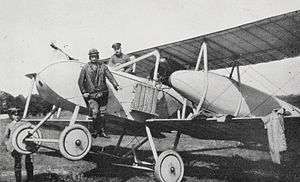AGO C.I
| C.I | |
|---|---|
 | |
| Role | Reconnaissance |
| Manufacturer | AGO Flugzeugwerke |
| Designer | A. Haefeli |
| Introduction | June 1915 |
| Primary user | Germany |
|
| |

AGO C.I
The AGO C.I was a First World War German pusher reconnaissance biplane that used a pod-and-boom configuration.
Development
The crew and pusher engine shared a central nacelle, and the twin booms carried the tail and the four-wheeled landing gear. The observer sat at the nose and was armed with a machine-gun.[1] It was produced in both two bay and three bay versions. A single example was fitted with floats for coastal patrol duties for the Imperial German Navy (designation C.I-W).
Operators
Specifications
General characteristics
- Crew: two, pilot and observer
- Length: 9.0 m (29 ft 6 in)
- Wingspan: 15.0 m (49 ft 2 in)
- Wing area: 41.5 m2 (447 ft2)
- Powerplant: 1 × Mercedes D.III, 117 kW (158 hp)
Performance
- Maximum speed: 140 km/h (90 mph)
- Range: 480 km (300 miles)
- Service ceiling: 4,800 m (16,000 ft)
Armament
References
- ↑ van Wyngarden, G (2006). Early German Aces of World War I, Osprey Publishing Ltd. ISBN 1-84176-997-5
- Taylor, Michael J. H. (1989). Jane's Encyclopedia of Aviation. London: Studio Editions. p. 39.
- Das Virtuelle Luftfahrtmuseum
See also
| Wikimedia Commons has media related to AGO C.I. |
- Aircraft of comparable role, configuration and era
Airco DH.6 - Royal Aircraft Factory F.E.2
This article is issued from Wikipedia - version of the 4/21/2016. The text is available under the Creative Commons Attribution/Share Alike but additional terms may apply for the media files.